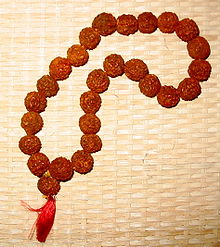- Hindu prayer beads
-
A Japa mala or mala (Sanskrit:माला; mālā, meaning garland[1]) is a set of beads commonly used by Hindus and Buddhists, usually made from 108 beads, though other numbers, usually divisible by 9, are also used. Malas are used for keeping count while reciting, chanting, or mentally repeating a mantra or the name or names of a deity. This practice is known in Sanskrit as japa.
Contents
Usage
Mantras are typically repeated hundreds or even thousands of times. The mala is used so that one can focus on the meaning or sound of the mantra rather than counting its repetitions. One repetition is usually said for each bead while turning the thumb clockwise around each bead, though some traditions or practices may call for counterclockwise motion or specific finger usage. When arriving at the head bead, one turns the mala around and then goes back in the opposing direction. There are typically knots between each bead. This makes using the mala easier as the beads will not be so tight on the string when you use them.
If more than 108 repetitions are to be done, then sometimes in Tibetan traditions grains of rice are counted out before the chanting begins and one grain is placed in a bowl for each 108 repetitions. Each time a full mala of repetitions has been completed, one grain of rice is removed from the bowl. Often, practitioners add extra counters to their malas, usually in strings of ten. These may be positioned differently depending on the tradition; for example some traditions place these strings after every 10th bead. This is an alternative way to keep track of large numbers, sometimes going into the hundreds of thousands, and even millions.
The 109th bead on a mala is called the sumeru, bindu, stupa, or guru bead. Counting should always begin with a bead next to the sumeru. In the Hindu, Vedic tradition, if more than one mala of repetitions is to be done, one changes directions when reaching the sumeru rather than crossing it.
There are numerous explanations why there are 108 beads, with the number 108 bearing special religious significance in a number of Hindu and Buddhist traditions.
In Hinduism
Hindu tradition holds that the correct way to use a mala is with the right hand, with the thumb flicking one bead to the next, and with the mala draped over the middle finger. The index finger represents ego, the greatest impediment to self-realization, so it is considered best avoided when chanting on a mala.
Regional variations
In Northeast India, particularly those in the Shakta traditions in West Bengal and Assam, the mala is often draped on the ring finger of the right hand, with beads moved by the middle finger with aid of the thumb and avoiding the use of the index finger. However, draping the mala over the middle finger and using the thumb to move the beads is also acceptable in these regions.
Materials
 Prayer beads made of rudraksha.
Prayer beads made of rudraksha.
A wide variety of materials are used to make mala beads, though there are common standards. Beads made from the seeds of the rudraksha tree are considered sacred by Saivas, devotees of Siva, while beads made from the wood of the tulsi plant are used and revered by Vaishnavas, followers of Vishnu. Some Tibetan Buddhist traditions call for the use of animal bone (most commonly yak), but sometimes human bone is used, those of past Lamas being the most valuable. Others use wood or seeds from the Bodhi tree or seeds of the Lotus plant. Semiprecious stones such as carnelian and amethyst may be used, as well. The most common and least expensive material is sandalwood. In Hindu Tantra, as well as Buddhist Tantra (or Vajrayana), materials and colors of the beads can relate to a specific practice.
Exact usage
The off head of the mala is usually called the Meru. Bring the tips of your ring-finger and thumb-finger together, and let the mala be hung at the junction. Start saying the mantra, at each repetition turn one bead with the middle finger, always allowing the index-finger to stand apart.
Traditionally, you should never cross the meru or "guru" bead. The mala should be turned in such a way that the 109th mantra is counted on the bead in which the 107th mantra was registered . [2]
Notes
- ^ Apte 1965, p. 758.
- ^ Kindle Life by H H Swami Chinmayanananda 1970, p. 109.
See also
- Aum Namah Shivaya mantra
- Buddhist prayer beads
- Hare Krishna mantra
- Kora (pilgrimage)
- Mahayana Buddhism
- Japa (spiritual discipline)
- Kombolói
- Prayer beads
- Tasbeeh
References
- Apte, Vaman Shivram (1965), The Practical Sanskrit Dictionary (Fourth revised and enlarged ed.), Delhi: Motilal Banarsidass Publishers, ISBN 81-208-0567-4
External links
- General Buddhist use of mala
- How to Chant using Japa beads - Hare Krishna
- Japa Group - discussing all aspects of chanting Hare Krsna Japa
- Japa Room - A friendly and constructive way to improve your Japa online in an audio/visual chatroom environment
- Japa Yoga - Sivananda Swami
- More On Japa, by Ramana Maharshi
- How to use the japa mala with prayer beads
Categories:- Objects used in Hindu worship
- Prayer beads
- Meditation
Wikimedia Foundation. 2010.

